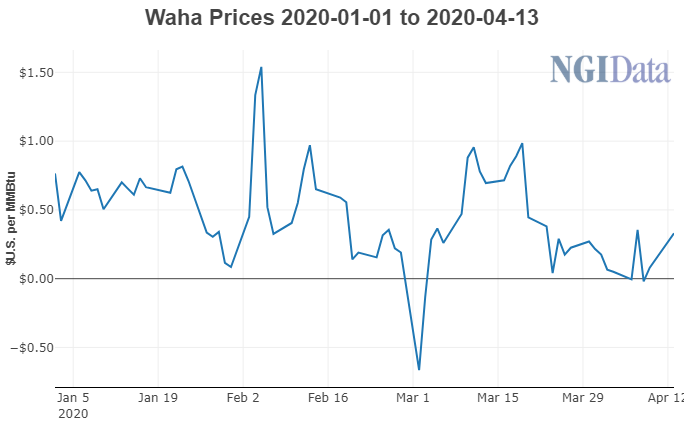Shale Daily | E&P | NGI All News Access | Permian Basin
U.S. Oil Well Shut-Ins Forecast to Gig Natural Gas Prices
As the U.S. oil supply declines from shut-in wells, analysts expect natural gas prices will see some relief, with the likelihood they could increase above $3.00/Mcf.

Tudor, Pickering, Holt & Co. (TPH) and Goldman Sachs Commodities Research each weighed in with somewhat optimistic — but cautious — notes about the outlook for U.S. natural gas, driven by reduced oil supply.
“In our view, as the oil price collapse is set to drive 5.5 Bcf/d of supply declines” from the end of 2019 to the end of 2020, “putting the market 4-5 Bcf/d undersupplied heading into 2021,” the TPH analysts said in a note Monday. “At $3/Mcf, we expect gas producers to continue to show restraint, with just 1 Bcf/d of gas-directed growth expected, meaning demand destruction may ultimately be the required path to a balanced market.”
If crude prices were to remain depressed to the end of this year, the 5.5 Bcf/d of expected associated gas declines may set the stage for “sustained $3.00-plus gas pricing,” the TPH analysts said.
If West Texas Intermediate oil prices were to be $50/bbl or higher, associated gas could be expected to increase by 1.5 Bcf/d. “But we see this being necessary to dig the market out of material undersupply and don’t see it being a threat to our $3 thesis,” said the TPH analysts. “After multiple years of associated gas being the scourge of the gas market, gas producers are positioned to regain control, and it likely means a prolonged period of very attractive pricing, provided the lessons of capital discipline are lasting.”
The gas pricing recovery then would accelerate because of associated gas shut-ins, with up to 7 Bcf/d possibly offline in the near term.
Even with the agreement last weekend by the Organization of the Petroleum Exporting Countries and its allies, aka OPEC-plus, it may not be enough to balance global crude markets in the near term, and U.S. oil output could be shut-in to restore balances. A 3 million bbl reduction would equal the 25% decline in refinery utilization, with an impact to gas supply of around 7 Bcf/d, according to TPH.
The Waha hub in West Texas, the gateway for Permian Basin gas, has been hit by negative pricing because infrastructure has been unable to keep up with associated gas growth. There’s been an estimated 3 Bcf/d on average wellhead growth over the past three years.
“We now see line of sight for a material recovery in price as production is set to decline in 2020,” the TPH analysts said. Even with estimated 1Q2020 flared gas volumes of 700 MMcf/d, wellhead volumes should decline over the next three quarters by 1.2 Bcf/d before oil well shut-ins.
Goldman analysts led by Samantha Dart recently talked about how U.S. oil well shut-ins during 2Q20020 offer an upside to this summer’s New York Mercantile Exchange (Nymex) gas price forecasts because more oil shut-ins mean less associated gas.
“This would open up room in storage, requiring lower C2G substitution to manage inventory levels, implying higher natural gas prices relative to our forecast,” the Goldman analysts said.
The deal by OPEC-plus may be insufficient to avoid hitting capacity in oil storage. That means “at least 4 million b/d of additional shut-ins are necessary globally in the near term,” according to Goldman analyst Damien Courvalin.
Goldman’s base case is for 1.5 million b/d of U.S. shut-ins during April and May, in addition to the 1 million b/d in domestic production declines between 1Q2020 and 4Q2020 reflected in the gas balances resulting from low oil prices.
“This results in an estimated 4.6 Bcf/d impact to U.S. natural gas production in that period, and a 2.1 Bcf impact to our previous 92.5 Bcf/d summer 2020 level expectations,” the Goldman analysts said.
The firm has revised expected U.S. LNG export cancellations this summer to 2 Bcf/d from 0.9 Bcf/d and slightly lowered assumptions for gas exports to Mexico by another 200 MMcf/d for the summer. The lower supply should be enough to make room in storage for lower coal-to-gas (C2G) substitutions and consequently, higher domestic gas prices. “Accordingly, we raise our 2Q2020 and 3Q2020 gas price forecasts to $1.75/MMBtu and $1.90/MMBtu from $1.60/MMBtu and $1.75/MMBtu to reflect a need for lower C2G substitution than what we expected previously.”
The firm is maintaining 2020/21 winter and 2021 summer Nymex forecasts at $3.50/MMBtu and $3.25/MMBtu, which is above current forwards at $2.74/MMBtu and $2.50/MMBtu.
Still, the firm said there is a high degree of uncertainty around expected changes to supply and demand in the coming months. “Specifically, if oil shut-ins are 0.5 million b/d lower than our expected 1.5 million b/d or if U.S. LNG cancellations are 1 Bcf/d higher than our base case, storage levels would be unsustainably high, above 4.4 Tcf.”
© 2024 Natural Gas Intelligence. All rights reserved.
ISSN © 2577-9877 | ISSN © 2158-8023 |
